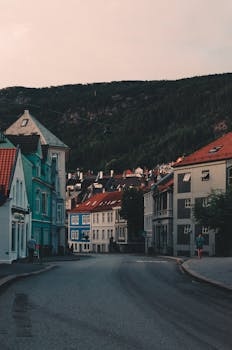Norway Food Guide
Content Information
Recently updated🔥Current Food Trends 2025
What's happening in Norway's culinary scene right now
Norway's culinary landscape in December 2025 celebrates New Nordic cuisine movement, seasonal harvest traditions, Arctic seafood sustainability, fjord-to-table dining, and modern Norwegian pastry innovation. December marks Christmas season (Jul) with traditional holiday foods: pinnekjøtt (lamb ribs), lutefisk (lye-treated cod), ribbe (pork ribs), and riskrem (rice pudding) with hidden almond tradition. Christmas markets in Bergen, Trondheim, and Oslo sell traditional foods including lefse, gingerbread (pepperkaker), and rømmegrøt. Maaemo (Oslo, three Michelin stars) and Kontrast showcase hyper-local ingredients and Arctic terroir. Arctic seafood dominance continues with Norwegian salmon (world's 2nd largest exporter), king crab from Finnmark, and cod from Lofoten. Sustainability focus drives MSC-certified fisheries and carbon-neutral shipping. Coffee culture thrives with Norwegians consuming world's 2nd highest per capita - specialty roasters like Fuglen and Tim Wendelboe lead third-wave movement. Brown cheese (brunost) resurgence sees artisan producers creating flavored variations. Craft beer revolution challenges restrictive alcohol laws with microbreweries producing innovative IPAs and sours. Foraging culture celebrates mushroom, berry, and seaweed workshops. December's polar night (zero daylight in far north, 4-6 hours in south) intensifies indoor dining and bakery culture with kanelboller (cinnamon buns) and skillingsboller dominating café counters. Wild game season features reindeer, elk, and grouse on restaurant menus. Bergen's fish market remains iconic seafood destination. Traditional Christmas baking includes seven types of cookies (sju slag) tradition. St. Lucia Day (December 13) celebrated with saffron buns (lussekatter). Sami indigenous culture preserves reindeer herding and traditional preparations like bidos stew.
Food Safety Tips
Essential food safety information to help you enjoy Norway's cuisine safely and confidently.
Tap water is exceptionally pure
Norwegian tap water is among the cleanest in the world and perfectly safe to drink throughout the country. Many locals prefer it to bottled water.
High food safety standards
Norway maintains extremely high food safety standards and strict regulations for food production and preparation.
Be cautious with raw fish
While Norway is known for excellent seafood, including raw preparations like gravlaks (cured salmon), those with compromised immune systems should exercise caution.
Note fermented preparations
Traditional fermented fish dishes like rakfisk (fermented trout) and lutefisk (lye-treated cod) have strong flavors and textures that may not appeal to all travelers.
Dietary Options
vegetarian
MEDIUM AVAILABILITYWhile traditional Norwegian cuisine is centered around fish, meat, and dairy, vegetarian options are widely available in cities and tourist areas.
vegan
MEDIUM AVAILABILITYVegan options have become increasingly common in urban areas, particularly in Oslo and Bergen. Mainstream restaurants now typically offer at least one vegan option.
gluten-free
MEDIUM AVAILABILITYAwareness of gluten intolerance is high in Norway, and gluten-free options are available in most restaurants and grocery stores, particularly in urban areas.
halal
LOW AVAILABILITYHalal food is available primarily in Oslo, Bergen, and other major cities with Muslim populations (approximately 5-6% of population, mostly immigrants). Halal-certified restaurants, butchers, and grocery stores exist in urban areas. Main challenges: Pork products common in traditional Norwegian cuisine (especially Christmas dishes); seafood abundance means many naturally halal options. Norwegian salmon, cod, and other fish are halal-friendly if properly slaughtered. Vegetarian options abundant. Download Zabihah app for Oslo/Bergen halal locations. Rural areas have very limited halal infrastructure.
kosher
VERY LOW AVAILABILITYKosher food is extremely limited in Norway with small Jewish community (approximately 1,000-1,500 people, mostly in Oslo). Oslo has one kosher restaurant (Det Mosaiske Trossamfunn - The Mosaic Religious Community) and limited kosher grocery options. Main challenges: Seafood without fins/scales common (shellfish, eel); dairy-meat mixing in traditional dishes; limited kosher supervision. Naturally kosher-friendly options: Norwegian salmon, cod (if scales visible), fresh produce, eggs. Contact Det Mosaiske Trossamfunn or Chabad Norway for current kosher dining. Travelers should bring kosher provisions or rely on sealed packaged goods, vegetarian options.
Common Allergens
Fish and Seafood
HIGH PREVALENCESeafood is fundamental to Norwegian cuisine and appears in many traditional dishes.
COMMONLY FOUND IN:
Dairy
HIGH PREVALENCEDairy products, especially cheese, are staples in Norwegian diet.
COMMONLY FOUND IN:
Gluten
MEDIUM PREVALENCEBread and baked goods are common in Norwegian cuisine, though perhaps less central than in some European countries.
COMMONLY FOUND IN:
Tree Nuts
MEDIUM PREVALENCENuts can be found in Norwegian baking and some traditional dishes.
COMMONLY FOUND IN:
Essential Food Experiences
These iconic dishes represent the must-have culinary experiences that define Norway's food culture for travelers.

Brunost (Brown Cheese)
A sweet, caramelized whey cheese with a distinctive brown color and sweet-savory flavor, often sliced thinly and eaten on bread or waffles. Made by boiling whey for hours until sugars caramelize. Unique to Norway, essential breakfast item.

Gravlaks
Raw salmon cured with salt, sugar, and dill, traditionally served with mustard sauce, on bread, or with potatoes. Scandinavian specialty showcasing Norway's premium salmon. Essential Norwegian appetizer or breakfast dish.

Fårikål
Norway's national dish consisting of mutton with bone, cabbage, black pepper, and often whole peppercorns, simmered until tender. Celebrated with national Fårikål Day (last Thursday before first Sunday in September). Autumn comfort food.

Norwegian Waffles (Vafler)
Heart-shaped, soft waffles typically served with sour cream (rømme) and jam, or brown cheese. Thinner and softer than Belgian waffles. Essential Sunday tradition (søndagsvafler). Often accompanied by coffee.

Kjøttkaker (Norwegian Meatballs)
Norwegian meatballs, different from Swedish counterparts, usually served with creamy brown gravy, potatoes, and lingonberry jam. Comfort food staple made from ground beef or pork. Essential Norwegian home cooking.

Rømmegrøt (Sour Cream Porridge)
Sour cream porridge, a traditional Norwegian dish made from sour cream, whole milk, wheat flour, butter, and salt, often topped with cinnamon and sugar. Rich, indulgent, festive dish served at celebrations.

Lutefisk
Traditional Christmas dish of aged stockfish (air-dried whitefish, usually cod) treated with lye (lut), creating distinctive gelatinous texture. Lutefisk polarizes - Norwegians either love or hate it. Soaked, boiled, served with bacon, peas, mustard, and potatoes. Represents Viking preservation methods and Norwegian culinary heritage. Essential Norwegian-American diaspora tradition. Challenging texture and acquired taste make lutefisk ultimate Norwegian food adventure.

Rakfisk (Fermented Trout)
Fermented freshwater trout, salted and aged for 2-3 months, developing pungent aroma and complex umami flavor. Served thinly sliced with flatbread (lefse), sour cream, onions, and potatoes. Rakfisk festivals in October-November celebrate this polarizing delicacy. Trøndelag and inland regions specialize in rakfisk. Represents ancient Norwegian preservation techniques predating refrigeration. Strong smell intimidates newcomers but flavor rewards adventurous eaters.

Reindeer Meat (Reinsdyrkjøtt)
Semi-domesticated reindeer raised by Sami indigenous people in northern Norway (Finnmark, Troms), prepared as steaks, stews, or bidos (traditional Sami stew). Lean, tender meat with subtle gamey flavor. Røros region and northern restaurants specialize in reindeer dishes. Sustainable, ethical meat from Arctic tundra grazing. Reindeer represents Sami culture, Arctic food systems, and Norwegian indigenous heritage. Often served with lingonberry sauce and root vegetables.

Skillingsboller (Cinnamon Buns)
Norwegian cinnamon buns with cardamom-spiced dough, cinnamon-sugar filling, often topped with pearl sugar. Less sweet than American cinnamon rolls, more aromatic from cardamom. Bakeries sell fresh skillingsboller daily - essential coffee (kaffe) pairing. Dark winter mornings make warm skillingsboller especially comforting. Represents Norwegian bakery culture and kos (coziness) philosophy. Regional variations include kanelboller and kanelsnurrer. Weekend tradition involves home baking for Sunday coffee (søndagskaffe).
Regional Specialties & Local Favorites
Discover the authentic regional dishes and local favorites that showcase Norway's diverse culinary traditions.

Pinnekjøtt (Christmas Lamb Ribs)
Dried and salted lamb ribs, traditionally steamed on birch sticks (hence the name 'stick meat'). Traditional Christmas dinner in western Norway. Time-consuming preparation (30 days drying) results in incredibly flavorsome meat. Served with mashed rutabaga (kålrabistappe) and potatoes.

Lefse
Soft Norwegian flatbread made from potatoes, flour, and milk, rolled thin and cooked on griddle. Served with butter, sugar, cinnamon, or brunost. Regional variations throughout Norway. Essential Christmas tradition and year-round staple.
Allergens:

Fiskesuppe (Fish Soup)
Creamy fish soup with salmon, cod, or shellfish, vegetables, and cream. Popular coastal dish showcasing Norwegian seafood. Warming, comforting, essential winter meal. Often served with bread.
Allergens:

Kvæfjordkake (World's Best Cake)
Norwegian layer cake with meringue top, vanilla cream filling, and sponge cake base. Named after Kvæfjord region in northern Norway. Called 'world's best cake' by Norwegians. Essential celebration dessert.
Allergens:

Raspeballer / Komle / Klubb
Potato dumplings with various regional names throughout Norway. Made from grated potatoes, sometimes with bacon or pork inside. Served with butter, bacon, and often rutabaga mash. Essential Norwegian comfort food with strong regional variations.
Regional Cuisine Highlights
Explore the diverse culinary landscapes across different regions of Norway.
Vestlandet (Western Norway)
Vestlandet cuisine emphasizes seafood, with dishes like fish soup and smoked salmon being common. Lamb and mutton are also prevalent, reflecting the region's mountainous terrain. Bergen's historic fish market (Fisketorget) has operated since 1200s, showcasing coastal bounty. Fjord-caught fish and coastal traditions dominate. Pinnekjøtt (lamb ribs) is traditional Christmas dish in this region.
Cultural Significance:
The region's proximity to the sea and mountainous landscape have shaped its cuisine, with a focus on fresh, local ingredients. Bergen's role as historic Hanseatic trading post influenced food preservation methods. Fishing heritage dominates culinary identity. Pinnekjøtt represents Christmas traditions unique to western Norway.
Signature Dishes:
- Fish soup (fiskesuppe)
- Smoked salmon (røkelaks)
- Pinnekjøtt (Christmas lamb ribs)
- Fresh cod and halibut
- Lamb stew
Key Ingredients:

Østlandet (Eastern Norway)
Østlandet cuisine features hearty dishes like stews and porridges, often made with locally grown grains and vegetables. Game meat is also common, reflecting the region's forested areas. Oslo's cosmopolitan food scene blends traditional and innovative approaches. Fårikål (mutton and cabbage stew) is especially popular here. Agricultural traditions shape regional identity.
Cultural Significance:
The region's agricultural history and vast forests have influenced its cuisine, with a focus on hearty, filling dishes. Oslo as capital brings international influences while preserving traditional Norwegian recipes. Fårikål's status as national dish reflects Østlandet's culinary importance. Forest foraging traditions remain strong.
Signature Dishes:
- Fårikål (mutton and cabbage stew)
- Potato lefse (flatbread)
- Raspeballer (potato dumplings)
- Game stew (elk, deer)
- Rømmegrøt (sour cream porridge)
Key Ingredients:

Trøndelag (Central Norway)
Trøndelag cuisine is known for its rich agricultural traditions, with dishes like sausages and cheeses being prominent. Seafood is also important, particularly salmon and trout from the region's rivers. Rakfisk (fermented trout) is Trøndelag specialty with dedicated autumn festival. Sodd (traditional soup) represents regional comfort food.
Cultural Significance:
The region's fertile land and abundant waterways have contributed to a diverse cuisine, with a focus on both land and sea-based ingredients. Trondheim as historic capital (997-1217) developed sophisticated food culture. Rakfisk festivals celebrate fermentation traditions. Agricultural richness creates distinctive regional identity.
Signature Dishes:
- Sodd (traditional mutton soup)
- Rakfisk (fermented trout)
- Røros reindeer
- Fresh salmon from Trøndelag rivers
- Local cheeses
Key Ingredients:

Nord-Norge (Northern Norway)
Northern Norway cuisine emphasizes Arctic seafood, reindeer, and Sami indigenous food traditions. King crab from Finnmark, Arctic cod from Lofoten, and reindeer herding by Sami people define regional identity. Midnight sun and polar night seasons influence eating patterns. Stockfish (tørrfisk) production in Lofoten represents centuries-old preservation methods.
Cultural Significance:
Northern Norway's Arctic location and Sami indigenous culture create unique culinary traditions. Reindeer herding by Sami people sustains traditional food systems. Midnight sun enables unique growing conditions for Arctic berries. King crab fishery showcases adaptation to environmental change. Stockfish trade dates to Viking era, connecting Norway to Mediterranean markets.
Signature Dishes:
- King crab from Finnmark
- Stockfish (tørrfisk) from Lofoten
- Reindeer stew (bidos)
- Arctic cod (skrei)
- Cloudberries (multe)
Key Ingredients:

Sweet Delights & Desserts
Indulge in Norway's traditional sweet treats and desserts.

Krumkake (Thin Waffle Cookies)
Thin, crispy waffle cookies rolled into delicate cones, often filled with whipped cream. Made with krumkake iron creating intricate patterns. Traditional Christmas cookie with cardamom flavor. Families prepare krumkake for upcoming holidays. Represents Norwegian baking heritage and festive traditions.

Riskrem (Rice Pudding)
Creamy rice pudding (risgrøt transformed with whipped cream) served with red berry sauce (usually raspberry). Hidden almond tradition - one almond hidden in pudding, finder wins marzipan pig prize. Essential Christmas Eve dessert. Sweet, comforting, representing Norwegian Christmas traditions dating to 1800s.

Bløtkake (Norwegian Cream Cake)
Light sponge cake layered with whipped cream and fresh berries (strawberries, raspberries), often decorated with marzipan or chocolate. Norway's birthday cake - essential for 17th May (Constitution Day) celebrations, graduations, weddings. Bløtkake means 'soft cake' referring to moist cream layers. Represents Norwegian celebration culture and summer berry abundance.

Kransekake (Wreath Cake)
Tower of almond-based ring cookies stacked to form cone shape, decorated with icing and Norwegian flags. Made for special occasions - weddings, Christmas, Constitution Day (17th May), New Year's Eve. Each ring made from almond flour, egg whites, sugar - no wheat flour. Labor-intensive, elegant dessert representing Norwegian festive traditions.

Tilslørte Bondepiker (Veiled Farm Girls)
Layered dessert with apple compote, toasted breadcrumbs, and whipped cream. Name means 'veiled farm girls' - cream 'veils' the layers. Traditional Norwegian dessert using humble ingredients (apples, bread). Sweet-tart apples contrast crunchy breadcrumbs and rich cream. Represents Norwegian resourcefulness and farm traditions.

Multekrem (Cloudberry Cream)
Whipped cream mixed with cloudberries (multe) - golden Arctic berries prized as Norwegian delicacy. Tart-sweet cloudberries grow wild in mountain bogs, harvested July-August, preserved for year-round use. Served chilled in bowls. Cloudberries command premium prices (expensive as saffron). Represents Norwegian foraging culture and Arctic terroir. Often paired with krumkake or waffles.

Serinakaker (Serina Cookies)
Soft, buttery cookies topped with candied cherries or almond halves. Traditional Christmas cookie named after baker's daughter Serina. Tender, melt-in-mouth texture from butter and almond flour. Christmas cookie baking season (sju slag - seven types tradition). Represents Norwegian Christmas baking heritage and home traditions.

Trollkrem (Troll Cream)
Fluffy, pink whipped dessert made from lingonberries and egg whites whipped into stiff peaks, sweetened with sugar. Name means 'troll cream' referring to magical transformation of simple ingredients. Light, airy, tart-sweet from lingonberries. Popular children's dessert and nostalgic treat. Represents Norwegian fairy tale culture and seasonal berry traditions.
Traditional Beverages
Discover Norway's traditional drinks, from locally produced spirits to regional wines.

Akevitt (Aquavit)
Akevitt is a traditional Scandinavian spirit flavored with caraway or dill, often served chilled.

Pilsner (Pilsner Beer)
Pilsner is a popular type of light lager beer in Norway.

Cider
Cider, both alcoholic and non-alcoholic, is a popular beverage choice in Norway.
Soft Beverages
Discover Norway's traditional non-alcoholic drinks, from local teas to refreshing juices.

Coffee (Kaffe)
Coffee is ubiquitous in Norway, which has world's 2nd highest per capita consumption. Specialty roasters like Fuglen and Tim Wendelboe lead third-wave coffee movement. Typically served black and strong, essential part of Norwegian culture.

Tea
Tea is also a common beverage, with various types available.

Solo (Orange Soda)
Norway's most popular soft drink since 1934. Orange-flavored carbonated soda considered 'Norway's national drink'. Ubiquitous at gatherings, barbecues, and celebrations. Distinctly Norwegian cultural icon.